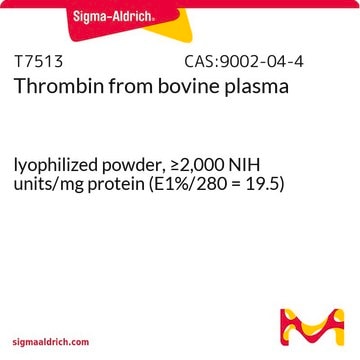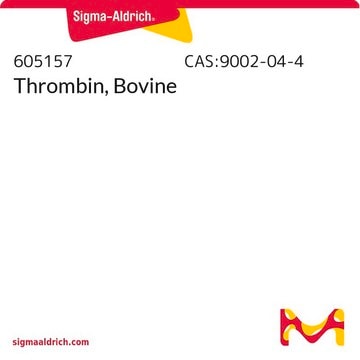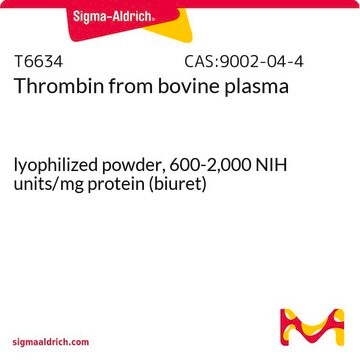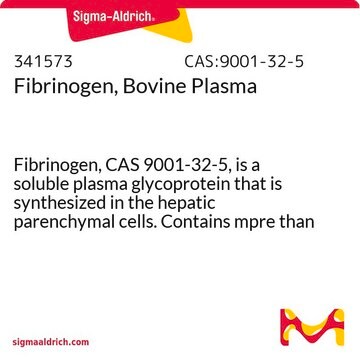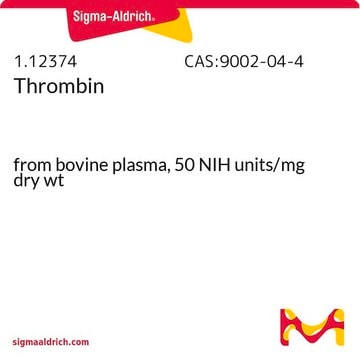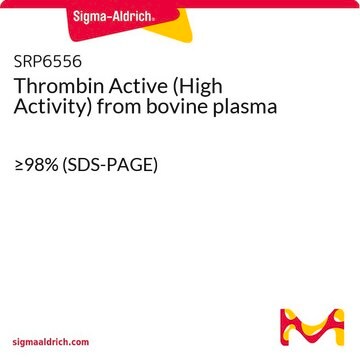The amount of thrombin to use depends on the protein expression system. Optimization is needed for each specific protein, and 1 to 10 units per mg of recombinant protein can be used as a starting point.
T4648
Thrombin from bovine plasma
lyophilized powder, 40-500 NIH units/mg protein (biuret)
Synonym(s):
Factor IIa
About This Item
Recommended Products
biological source
bovine plasma
Quality Level
form
lyophilized powder
specific activity
40-500 NIH units/mg protein (biuret)
mol wt
heavy chain ~33 kDa
light chain ~5 kDa
composition
Protein, 40-60%
UniProt accession no.
shipped in
wet ice
storage temp.
−20°C
Gene Information
cow ... F2(280685)
Looking for similar products? Visit Product Comparison Guide
General description
Application
Biochem/physiol Actions
Unit Definition
Physical form
Preparation Note
Analysis Note
Other Notes
inhibitor
Signal Word
Danger
Hazard Statements
Precautionary Statements
Hazard Classifications
Eye Irrit. 2 - Resp. Sens. 1 - Skin Irrit. 2 - STOT SE 3
Target Organs
Respiratory system
Storage Class Code
11 - Combustible Solids
WGK
WGK 2
Flash Point(F)
Not applicable
Flash Point(C)
Not applicable
Choose from one of the most recent versions:
Certificates of Analysis (COA)
Don't see the Right Version?
If you require a particular version, you can look up a specific certificate by the Lot or Batch number.
Already Own This Product?
Find documentation for the products that you have recently purchased in the Document Library.
Customers Also Viewed
-
I just bought this thrombin to cleave HisTag from recombinant proteins but I am struggling in understanding how much /mg of purified recombinant protein I have to use. Do you have any suggestion? Thanks a lot
1 answer-
Helpful?
-
-
How do i dissolve the lyophilized powder of T4648 bovine thrombin of 40-300 NIH units/mg
1 answer-
This product is soluble in water at 10 mg/mL. Stock solutions may be prepared at 100 units/mL in water containing 0.01% BSA. Please see the link below to review the product datasheet for additional information, including solution stability and storage:
https://www.sigmaaldrich.com/deepweb/assets/sigmaaldrich/product/documents/335/094/t4648dat.pdfHelpful?
-
-
What is the bottle information for T4648-1KU and T4648-10KU?
1 answer-
Both products are packaged in a 20 ML Amber glass bottle with a 24-400 thread.
Helpful?
-
-
I was cleave gfp from my protein which is dissovled in PBS. Should I make thrombin stock in pbs or bsa?
1 answer-
The recommended preparation instructions, per the product information sheet, are 10 mg/mL in water or 100 units/mL in a 0.01% BSA solution. Stock solutions of either aforementioned recommendations can then be added to PBS at the desired usage concentration. The addition of BSA to the stock solution will aid in long-term product stability when stored at -20 deg. C. See the link below to review the product information sheet:
https://www.sigmaaldrich.com/deepweb/assets/sigmaaldrich/product/documents/335/094/t4648dat.pdfHelpful?
-
-
What is the purity of this product?
1 answer-
The purity of this product is not determined. The biuret method is used to verify the protein content. In general, products with higher activity levels can be considered higher in 'purity'. See the link below to other bovine thrombin products for comparison:
https://www.sigmaaldrich.com/substance/thrombinfrombovineplasma123459002044.Helpful?
-
-
For thrombin, how do NIH units compare to International Units (IU)?
1 answer-
One NIH unit of thrombin is equivalent to approximately 1.8 International Unit (IU) of thrombin.
Helpful?
-
-
What is the Department of Transportation shipping information for this product?
1 answer-
Transportation information can be found in Section 14 of the product's (M)SDS.To access the shipping information for this material, use the link on the product detail page for the product.
Helpful?
-
-
What is the solution stability of Product T4648, Thrombin from bovine plasma?
1 answer-
When stock solutions of thrombin from bovine plasma are prepared at a concentration of 100 units/mL in 0.1% (w/v) BSA, they are stable for one week at 0-5°C. Since thrombin solutions adsorb to glass, it is recommended to aliquot the solutions in plastic tubes and store at -20°C for long term storage.
Helpful?
-
-
How is the activity of Product T4648, Thrombin from bovine plasma, determined?
1 answer-
The thrombin from bovine plasma activity is determined with a clotting assay (conversion of fibrinogen to fibrin) which measures alpha-thrombin and the amount of beta- and gamma-thrombin present is not measured. The assay of the clotting activity of thrombin from bovine plasma is performed at pH 7, utilizing a NIH thrombin reference standard.
Helpful?
-
-
What is the solubility of Product T4648, Thrombin from bovine plasma?
1 answer-
Thrombin from bovine plasma is soluble in water at 10 mg/mL.
Helpful?
-
Active Filters
Our team of scientists has experience in all areas of research including Life Science, Material Science, Chemical Synthesis, Chromatography, Analytical and many others.
Contact Technical Service

